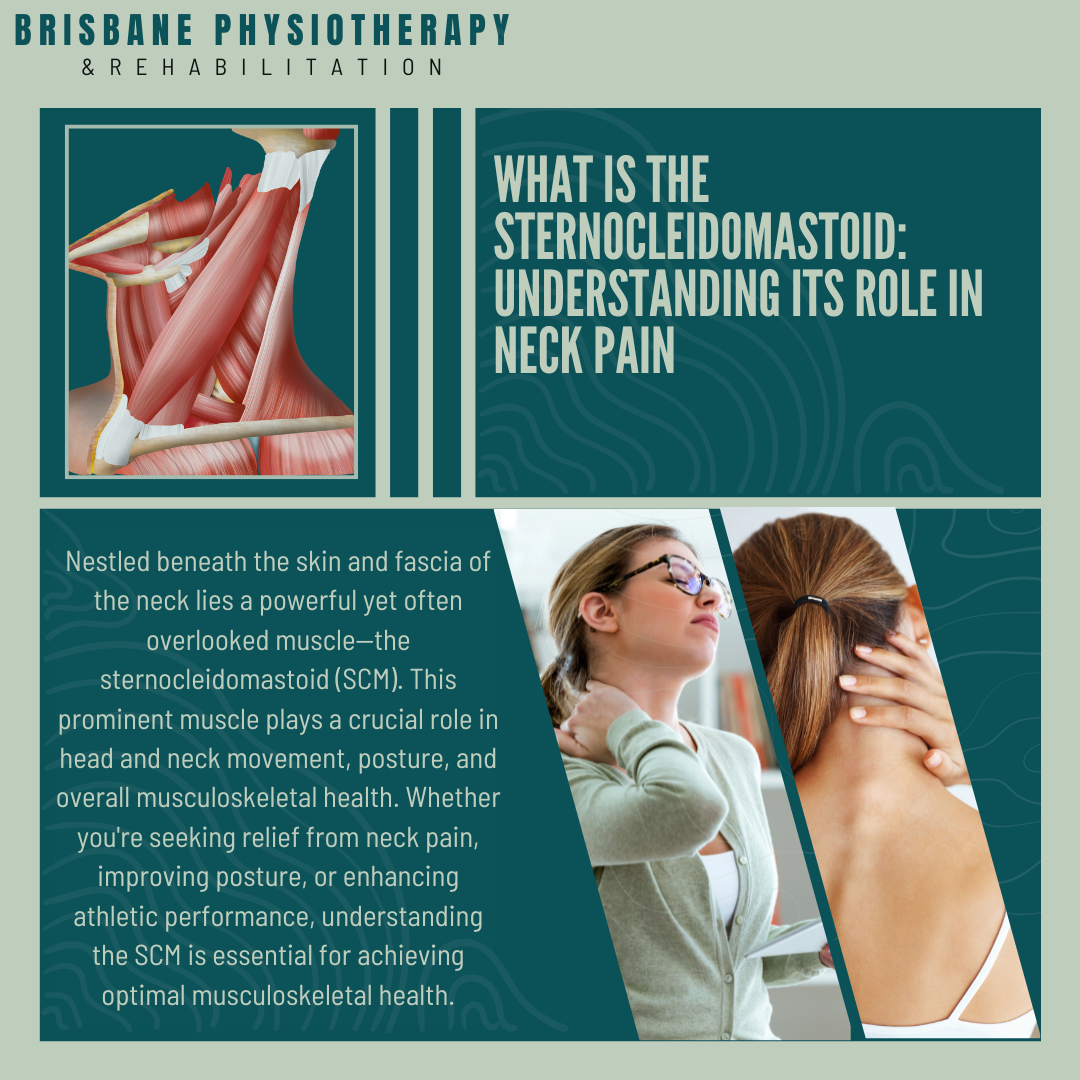What is the Sternocleidomastoid: Understanding Its Role in neck pain
Introduction:
Nestled beneath the skin and fascia of the neck lies a powerful yet often overlooked muscle—the sternocleidomastoid (SCM). This prominent muscle plays a crucial role in head and neck movement, posture, and overall musculoskeletal health. As physiotherapists, we recognize the significance of the SCM in maintaining optimal function and mobility. In this blog post, we'll delve into the anatomy, function, common dysfunctions, and management strategies related to the sternocleidomastoid muscle. Whether you're seeking relief from neck pain, improving posture, or enhancing athletic performance, understanding the SCM is essential for achieving optimal musculoskeletal health.
Anatomy and Function of the Sternocleidomastoid:
The sternocleidomastoid muscle derives its name from its origins at the sternum (sterno-), clavicle (cleido-), and mastoid process of the temporal bone (mastoid). It consists of two slender muscle bellies—one on each side of the neck—that converge to insert onto the mastoid process and superior nuchal line of the occipital bone. The primary functions of the SCM include:
Head Flexion: Acting bilaterally, the SCM flexes the head forward, bringing the chin towards the chest.
Head Rotation: Acting unilaterally, the SCM rotates the head to the opposite side of the contracting muscle.
Lateral Flexion: Acting unilaterally, the SCM tilts the head towards the same side as the contracting muscle.
Assisting in Respiratory Function: The SCM can aid in the elevation of the sternum during forced inhalation, facilitating increased lung capacity.
Common Dysfunctions and Symptoms:
Dysfunction of the sternocleidomastoid muscle can manifest in various ways, leading to a range of symptoms, including:
Neck Pain: Tension, strain, or trigger points within the SCM can result in localized neck pain, stiffness, and discomfort.
Headaches: Dysfunction of the SCM may contribute to tension headaches, particularly those originating from trigger points in the muscle.
Limited Range of Motion: Tightness or dysfunction in the SCM can restrict neck movement, leading to reduced flexibility and mobility.
Postural Imbalances: Imbalances in SCM length or strength can contribute to asymmetrical head positioning, forward head posture, and shoulder elevation.
Temporomandibular Joint (TMJ) Dysfunction: The SCM's attachment to the mastoid process can indirectly influence TMJ function and contribute to jaw pain or dysfunction.
Management Strategies for Sternocleidomastoid Dysfunction:
Effective management of SCM dysfunction typically involves a multifaceted approach addressing both muscle tension and underlying contributing factors. Here are some key strategies:
Manual Therapy Techniques: Hands-on techniques such as massage, myofascial release, and trigger point therapy can help alleviate tension and promote relaxation within the SCM.
Stretching and Mobility Exercises: Gentle stretching and mobility exercises targeting the SCM and surrounding neck muscles can help improve flexibility and reduce stiffness.
Postural Correction: Emphasise proper posture awareness and corrective exercises to address postural imbalances and reduce strain on the neck muscles, including the SCM.
Strengthening Exercises: Incorporate strengthening exercises targeting the deep neck flexors, upper back, and shoulder stabilisers to support proper head and neck alignment.
Ergonomic Modifications: Assess and modify ergonomic factors such as workstation setup, pillow support, and screen height to promote neutral neck alignment and reduce strain on the SCM.
Stress Management: Implement stress reduction techniques such as relaxation exercises, mindfulness, and breathing techniques to alleviate muscle tension and promote overall well-being.
Conclusion:
The sternocleidomastoid muscle plays a pivotal role in head and neck function, posture, and overall musculoskeletal health. By understanding its anatomy, function, and management strategies for dysfunction, individuals can take proactive steps to address neck pain, improve posture, and enhance mobility. Whether through manual therapy, targeted exercises, ergonomic modifications, or stress management techniques, prioritising SCM health is essential for optimising musculoskeletal function and promoting overall well-being. If you're experiencing persistent neck pain or symptoms related to SCM dysfunction, don't hesitate to consult with a qualified physiotherapist at Brisbane Physiotherapy for a personalised assessment and treatment recommendations.

